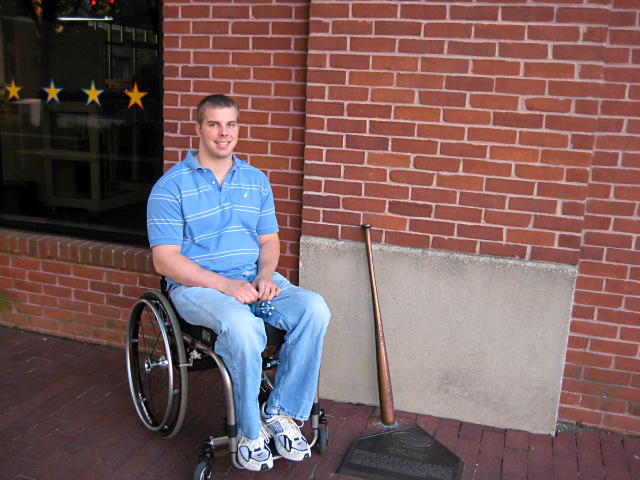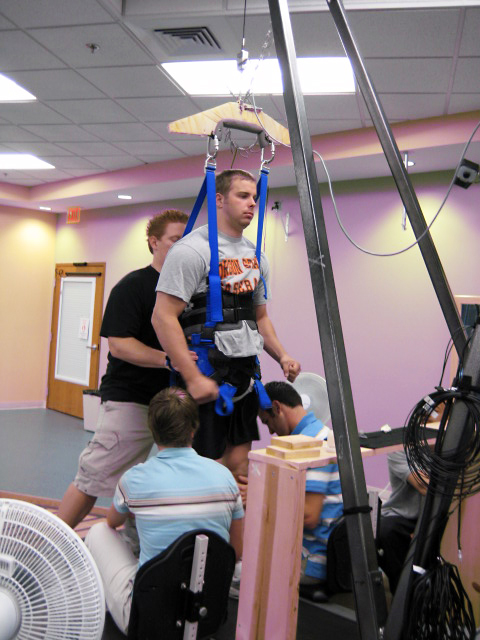
A hit-and-run accident left 25-year-old Rob Summers paralyzed in July 2006. Experimental treatments developed in part by UCLA have led to the recovery of the use of his legs.
Credit: University of Louisville
Rob Summers has not been able to stand on his feet for the past four years.
The 25-year-old Portland, Ore., man and former college baseball pitcher was paralyzed from the waist down in a hit-and-run car accident in July 2006.
But now, Summers can move his legs and toes and even take steps on a treadmill with assistance from experimental treatment developed at UCLA and two other universities.
“For someone who, for four years, was unable to even move a toe, to have the freedom and ability to stand on my own is the most amazing feeling,” Summers said in a news conference last week.
The research team, which included scientists from the University of Louisville and the California Institute of Technology, discovered a new pathway to improve voluntary movement for people with severe spinal cord injuries, said Reggie Edgerton, a lead author of the study and professor of integrative biology and physiology at UCLA.
The findings were published in The Lancet medical journal last week.
As with most spinal cord injuries, Summers’ cord was not completely severed. But the damage was severe enough to impede the brain from signaling the spinal cord to initiate movement in the lower half of his body.
As part of his rehabilitation, Summers underwent extensive locomotor training to “reteach” his body how to move. He was suspended from a harness while researchers moved his legs to simulate stepping motions.
A pacemaker-like device sends an electrical current through 16 electrodes implanted in his spine. This device triggers the neurons in his spine, allowing them to react to neural signals in his legs.
Summers can now stand unassisted for four minutes, move his toes, ankles, knees and hips, and take steps on a treadmill aided with a harness, stated a UCLA press release.
Researchers already knew from studies with mice that the spinal cord can learn motor tasks it is taught, even in the absence of any input from the brain, Edgerton said.
A technique called epidural stimulation allows Summers to move his lower body. Scientists stimulate electrical signals normally sent by the brain that control movement. Once these signals are given, the spinal cord’s own neural network, in conjunction with the sensory information from the legs and spinal cord, is able to direct movement.
“We used to think that once you damaged your spinal cord, that was it,” said Michael Sofroniew, professor of neurobiology at the David Geffen School of Medicine.
But these findings indicate that the nerves in the spinal cord are able to function the same way as the nerves in the brain.
In January 2008, a UCLA study authored by Sofroniew concluded that the central nervous system can reorganize itself and follow new pathways to restore the communication network required for movement.
It was previously believed that the only way for injured patients to walk again was to regrow the long nerve pathways that link the brain and base of the spinal cord.
Despite the success of Summers’ treatment, Edgerton and the other researchers said there is more progress to be made in the field. For now, this is only an experimental undertaking, not ready to be considered by those who wish to walk on the ground again, said Bruce Dobkin, professor of neurology and director of the Neurologic Rehabilitation and Research Program at UCLA.
More than 5 million Americans live with some form of paralysis, while 1.275 million have had a spinal cord injury, according to a press release from the Christopher and Dana Reeve Foundation, a sponsoring organization of the research.
The implications of Edgerton’s study may help individuals with Parkinson’s disease and stroke, as well as others with forms of paralysis, Edgerton said. Because this is the first study of its kind involving humans, the same treatment must be replicated on other subjects in the future.
